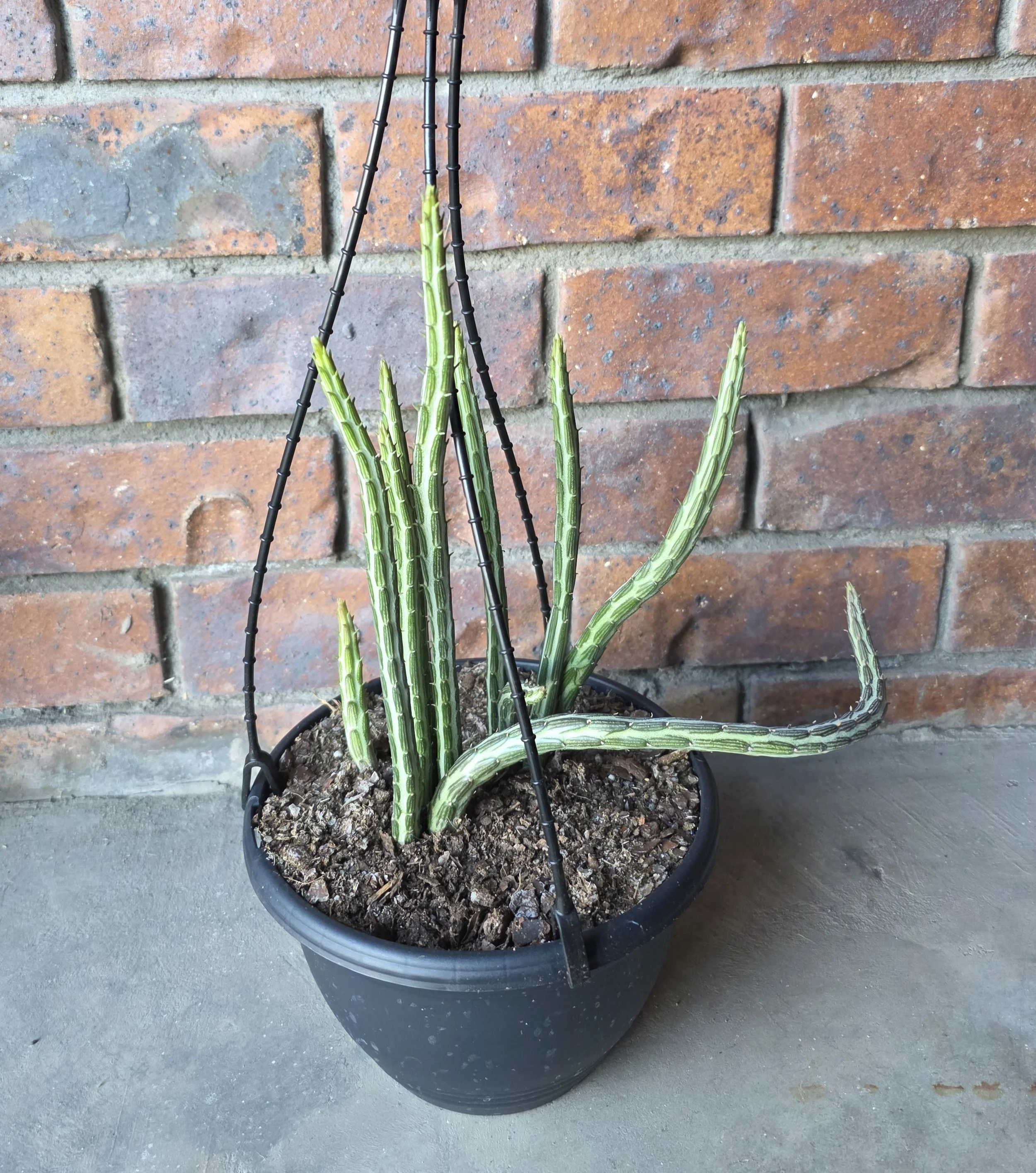 Image 1 of 1
Image 1 of 1


Senecio stapeliiformis 200mm
Senecio stapeliiformis, a striking and unusual succulent:
🌵 Senecio stapeliiformis
Common Names:
Pickle Plant, Kleinia stapeliiformis (former name), Candle Plant, Snake Plant (not to be confused with Sansevieria)
Family:
Asteraceae (Daisy family)
Native Range:
South Africa – particularly the Eastern Cape and Karoo regions
📏 Physical Description
Growth Habit:
A clump-forming, upright succulent with distinctive, cylindrical stems that can grow 20–30 cm tall (8–12 inches).
Growth is slow to moderate, forming a small, architectural clump over time.Stems:
The most eye-catching feature. Stems are green with deep purple or maroon mottling, often 4-angled or ribbed, and resemble cactus stems or pickle-like rods.
They can sometimes develop soft, white bristle-like hairs along the ribs.Leaves:
Tiny, ephemeral scale-like leaves appear along the ribs but usually fall off quickly.
🌸 Flowers
Appearance:
Produces striking orange-red tubular flowers that resemble miniature fireworks or paintbrushes, typical of the daisy family.
Flowers appear on long stalks (up to 30 cm or 12 in) rising above the plant in summer or early autumn.Scent:
Mildly sweet, sometimes said to be vanilla-scented.
🌱 Care and Cultivation
Light:
Thrives in bright light to full sun.
Can tolerate partial shade, but this may reduce the vibrancy of its color and encourage legginess.Watering:
Typical succulent watering needs—allow soil to dry out completely between waterings.
More watering during the growing season (spring/summer); minimal in winter.Soil:
Prefers well-draining, gritty soil—ideal is a cactus or succulent mix. Add sand or pumice for extra drainage.Temperature:
Enjoys warm conditions; ideal temperature range is 18–26°C (65–80°F).
Protect from frost—do not expose to temperatures below 5°C (41°F).Humidity:
Prefers low humidity, similar to its arid natural environment.Feeding:
Feed lightly with a cactus fertilizer once a month during spring and summer.Propagation:
Easily propagated by stem cuttings—let cuttings callous before planting in dry soil.
✅ Quick Care Summary
RequirementDetailsLightBright light to full sunWateringInfrequent; let soil dry completelySoilVery well-draining, gritty mixTemperature18–26°C; protect from frostFeedingMonthly during growing seasonPropagationStem cuttings
✅ Common Uses
Great for container gardens, rockeries, succulent bowls, and windowsill displays.
Its vertical, alien-like form gives a modern, sculptural look to arrangements.
⚠️ Common Issues
Overwatering: Leads to stem rot—most common mistake.
Leggy growth: Due to low light; provide more sun to keep it compact.
Pest issues: Rare, but may occasionally attract mealybugs or spider mites.
🪴 Style Tip for Brisbane:
This plant thrives in outdoor pots or sunny balconies where it can soak up light. Mix it with other sculptural succulents like Euphorbia, Crassula, or Aloe for a bold, geometric display.
Let me know if you'd like a succulent companion guide or pot arrangement ideas featuring this species!
Senecio stapeliiformis, a striking and unusual succulent:
🌵 Senecio stapeliiformis
Common Names:
Pickle Plant, Kleinia stapeliiformis (former name), Candle Plant, Snake Plant (not to be confused with Sansevieria)
Family:
Asteraceae (Daisy family)
Native Range:
South Africa – particularly the Eastern Cape and Karoo regions
📏 Physical Description
Growth Habit:
A clump-forming, upright succulent with distinctive, cylindrical stems that can grow 20–30 cm tall (8–12 inches).
Growth is slow to moderate, forming a small, architectural clump over time.Stems:
The most eye-catching feature. Stems are green with deep purple or maroon mottling, often 4-angled or ribbed, and resemble cactus stems or pickle-like rods.
They can sometimes develop soft, white bristle-like hairs along the ribs.Leaves:
Tiny, ephemeral scale-like leaves appear along the ribs but usually fall off quickly.
🌸 Flowers
Appearance:
Produces striking orange-red tubular flowers that resemble miniature fireworks or paintbrushes, typical of the daisy family.
Flowers appear on long stalks (up to 30 cm or 12 in) rising above the plant in summer or early autumn.Scent:
Mildly sweet, sometimes said to be vanilla-scented.
🌱 Care and Cultivation
Light:
Thrives in bright light to full sun.
Can tolerate partial shade, but this may reduce the vibrancy of its color and encourage legginess.Watering:
Typical succulent watering needs—allow soil to dry out completely between waterings.
More watering during the growing season (spring/summer); minimal in winter.Soil:
Prefers well-draining, gritty soil—ideal is a cactus or succulent mix. Add sand or pumice for extra drainage.Temperature:
Enjoys warm conditions; ideal temperature range is 18–26°C (65–80°F).
Protect from frost—do not expose to temperatures below 5°C (41°F).Humidity:
Prefers low humidity, similar to its arid natural environment.Feeding:
Feed lightly with a cactus fertilizer once a month during spring and summer.Propagation:
Easily propagated by stem cuttings—let cuttings callous before planting in dry soil.
✅ Quick Care Summary
RequirementDetailsLightBright light to full sunWateringInfrequent; let soil dry completelySoilVery well-draining, gritty mixTemperature18–26°C; protect from frostFeedingMonthly during growing seasonPropagationStem cuttings
✅ Common Uses
Great for container gardens, rockeries, succulent bowls, and windowsill displays.
Its vertical, alien-like form gives a modern, sculptural look to arrangements.
⚠️ Common Issues
Overwatering: Leads to stem rot—most common mistake.
Leggy growth: Due to low light; provide more sun to keep it compact.
Pest issues: Rare, but may occasionally attract mealybugs or spider mites.
🪴 Style Tip for Brisbane:
This plant thrives in outdoor pots or sunny balconies where it can soak up light. Mix it with other sculptural succulents like Euphorbia, Crassula, or Aloe for a bold, geometric display.
Let me know if you'd like a succulent companion guide or pot arrangement ideas featuring this species!